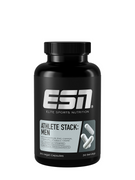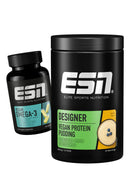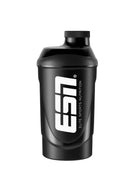Basistipps
Ein erfahrener Trainingspartner ist Gold wert
Mit einem Trainingspartner gestaltet sich der Muskelaufbau für Anfänger gleich doppelt so effektiv. Warum das so ist, liegt auf der Hand, denn dieser kann nicht nur Übungen demonstrieren und über den einen oder anderen Kniff bei Training und Ernährung informieren, sondern wirkt auch als Motivator. Ein guter Trainingspartner pusht zu Höchstleitungen und motiviert selbst müde Athleten dazu, den Weg ins Studio anzutreten, statt auf der Couch liegen zu bleiben.
Hinzu kommt die Funktion des Trainingspartners als Spotter, der es ermöglicht, dass Anfänger auch bei komplexen Grundübungen wie Kniebeugen, Bankdrücken oder der Military-Press gefahrlos an ihre Grenzen gehen können. Bis du einen solchen Partner gefunden hast, können Videoanleitungen hilfreich sein.
Großen Wert auf die Regeneration legen
Die Muskulatur wächst nicht beim Training, sondern in den Ruhephasen zwischen den einzelnen Workouts. Wer seinen Muskelaufbau also voranbringen möchte, sollte seiner Muskulatur nach jeder Trainingseinheit gut 48 bis 72 Stunden Erholung gönnen, bevor dieselbe Muskelgruppe abermals mit einem Trainingsreiz belastet wird. Wichtig für die optimale Regeneration ist auch regelmäßiger und darüber hinaus ausreichender Schlaf.
Als ideal gelten abhängig vom einzelnen Individuum zwischen 6 und 9 Stunden pro Nacht. Wichtig ist die Schlafdauer insbesondere deshalb, da die Regeneration von Körper und Geist vor allem in der Tiefschlafphase stattfindet. Im Umkehrschluss kann dauerhafter Schlafmangel hingegen zu einer Reduktion der Wachstumshormonausschüttung führen. Weitere negative Folgen von zu wenig Schlaf: Die Testosteronproduktion verringert sich, die Fettverbrennung wird schlechter, der Heißhunger auf Junkfood wächst. Also: Gute Nacht!
Steigere dich regelmäßig
Was bringt das Krafttraining, wenn die Muskulatur nicht regelmäßig vor neue Herausforderungen gestellt wird? Richtig, gar nichts. Deshalb ist es besonders wichtig, das Prinzip des progressiven Fortschritts (Progressive Overload) zu beherzigen. Dieses besagt im Grunde genommen, dass sich ein Athlet, egal ob Anfänger oder Fortgeschrittener, bei jeder Trainingseinheit zumindest ein bisschen steigern sollte.
Es muss nicht immer gleich eine massive Erhöhung des Trainingsgewichts sein, denn das ist binnen so kurzer Zeit auch nicht unbedingt realistisch. Es reicht bereits aus, einfach eine Wiederholung mehr pro Satz oder auch nur pro Übung aus der Muskulatur herauszuquetschen, sodass sich die bewegte Gesamtlast erhöht. Eine Erhöhung des Gewichts ist im Übrigen immer dann angesagt, wenn das aktuelle Trainingsgewicht auch im letzten Satz noch immer 12 Mal sauber bewegt werden kann.
Nicht auf die anderen achten
Gerade im Fitnessstudio neigen viele Anfänger dazu, sich zu stark an den anderen Athleten zu orientieren, die in der Regel deutlich erfahrener sind. In der Folge wollen Sie so schnell wie möglich schwere Gewichte stemmen und überschätzen sich. Andere hingegen schauen sich unsaubere Techniken ab und halten diese für richtig, da der Athlet, von dem sie sich die Technik abgeschaut haben, schließlich eine gute Form hat. Beim Muskelaufbau für Anfänger gilt allerdings genau das Gegenteil.
Jeder sollte sich zunächst auf sich selbst konzentrieren und sich nach dem eigenen Plan in kontinuierlichen Schritten nach vorne arbeiten. Dumme Sprüche, warum man bei Übung X oder Y ein geringes Gewicht verwendet, sollten ebenso ignoriert werden, wie anderweitige negative Bemerkungen. Wer sein Training aber mit Disziplin und der Unterstützung eines erfahrenen Trainingspartners durchzieht, wird in jedem Fall Erfolge feiern.
Den Trainingsplan nicht ständig ändern
Ja, die Welt des Bodybuildings ist neu und der Muskelaufbau für Anfänger ein zunächst aufregendes Unterfangen. Es ist also nicht selten, dass häufig zwischen verschiedenen Trainingssystemen und Plänen gewechselt wird, um es einmal ausprobiert zu haben oder, um vermeintlich ausbleibende Erfolge zu erzwingen. Auch das ist kontraproduktiv, da jedes Trainingssystem mindestens vier bis sechs Wochen braucht, bis Erfolge deutlich sichtbar werden. Es ist also gerade am Anfang wichtig, erst einmal einige Monate bei einem einzigen System zu bleiben. Dazu empfiehlt sich beispielsweise ein klassisches Ganzkörpertraining mit freien Gewichten, das ca. drei Mal pro Woche absolviert wird. Nach vier bis sechs Monaten kann schließlich zu einem Split-System gewechselt werden.
Keep it smart and simple
Das Bodybuilding ist eine äußerst facettenreiche Sportart, die sich durch unterschiedlichste Herangehensweisen, Ernährungsstrategien und Workout-Systeme auszeichnet, die zu allem Überfluss auch noch miteinander kombiniert werden können. Perfekt wird die Verwirrung, wenn auch noch nicht minder komplexe Ernährungspläne und exotische Trainingsstrategien ins Spiel kommen.
Einer der wichtigsten Tipps für Anfänger lautet daher: Sei schlau und halte das Training und die Ernährung zunächst so einfach wie möglich. Das erleichtert das Durchhalten enorm und schafft darüber hinaus eine wertvolle Erfahrungsbasis, die für spätere Spezialisierungen und Experimente genutzt werden kann. Bis es zu solchen Experimenten kommt, können aber gut und gerne 6-12 Monate ins Land gehen.

Trainingstipps
So früh wie möglich trainieren
Wer früh am Tag trainiert, hat den Vorteil, dass die Stoffwechselaktivität des Organismus über den ganzen Tag hinweg erhöht bleibt. Damit gelangen die Nährstoffe, die im Tagesverlauf aufgenommen werden, ebenso schnell wie kontinuierlich in die Muskelzellen, wo sie deutlich effektiver verarbeitet werden können als in den Abend- und Nachtstunden. Die optimierte Proteinzufuhr und Aufnahme führt darüber hinaus zu einem verstärkten Aufbau von fettfreier Körpermasse, sprich Muskulatur.
Als Anfänger wirst du mit deinem Training zunächst während jeder Tageszeit gute Fortschritte erzielen können, auch wenn ein früher Trainingszeitpunkt ein kleines Extra ist. Je fortgeschrittener dein Training wird, desto wichtiger wird der Trainingszeitpunkt, um Stagnation zu vermeiden oder einen Maximalkraftzyklus voll auszunutzen. Wer morgens oder vormittags trainieren kann, sollte diesen Vorteil also unbedingt nutzen, denn welchen besseren Start in den Tag könnte es geben als Sport?
Weder vor, noch nach dem Training dehnen
Einen der größten Fehler gilt es gleich vor dem Training zu vermeiden, denn dieser kostet unter dem Strich Leistung und damit auch einen gehörigen Anteil des maximal möglichen Wachstumsreizes, der im Training gesetzt werden kann. Auch wenn das leichte Dehnen vor dem Ausdauertraining durchaus seine Berechtigung hat, sollte es sowohl unmittelbar vor dem Krafttraining als auch direkt danach vermieden werden. Vor dem Training führt die Dehnung zu einer Reduktion der Spannung in der Muskulatur, sodass vor allem die maximal mobilisierbare Kraft leidet.
Achtung Verwechslungsgefahr: Dehnen ist nicht dasselbe wie zielgerichtetes Stretching! Beim Dehnen wird die Spannung mehrere Sekunden gehalten, Stretching entspricht einer fließenden Bewegung in die Dehnung und wieder hinaus. Stretching hilft dir außerdem, Verletzungen zu vorzubeugen. Regenerationsfördernd sind außerdem Hartkunststoffrollen, mit welchen sich verspannte Muskelgruppen selbst massieren lassen, beispielsweise Foam Rolling.
Erst die großen Muskeln, trainieren, dann erst die kleinen
Die Empfehlung große Muskeln beziehungsweise Muskelgruppen wie den Rücken oder die Brust vor kleineren Muskeln wie den Bizeps oder den Trizeps zu trainieren, beruht auf der Vermeidung der muskulären Vorermüdung. Wird nämlich der Bizeps mittels diverser Curls vor dem Rücken trainiert, ist dieser sehr kleine Muskel bereits erschöpft. Kontraproduktiv für den Muskelaufbau ist das, weil der Bizeps auch beim Rückentraining als Hilfsmuskel benötigt wird. Ist der Bizeps aber nun schon vorermüdet, ist es wahrscheinlich, dass er deutlich vor dem Rücken schlappmacht und damit keine idealen Wachstumsreize für die Rückenmuskulatur gesetzt werden können.
Grundübungen in das Training einbauen
Dieser Tipp schließt sich nahtlos an den vorherigen Tipp, da die Ausführung von Grundübungen auf den allgemeinen Vorteilen des Trainings mit freien Gewichten aufbaut. Grundübungen zeichnen sich durch ihre Komplexität aus, die auf der Tatsache basiert, dass mindestens zwei Gelenke und mehrere Muskelgruppen an einem solchen Bewegungsablauf beteiligt sind.
Grundübungen erhöhen damit nicht nur die koordinativen Fähigkeiten und die funktionale Kraft, sondern sorgen durch die Beteiligung eines großen Anteils der Skelettmuskulatur für eine deutlich höhere Ausschüttung von Wachstumshormonen, die den Muskelaufbau ankurbeln. Zudem lässt sich mit Grundübungen viel Zeit sparen, da diese leicht mehrere Isolationsübungen ersetzen können. Somit lässt sich auch eine optimale Trainingszeit von 45-60 Minuten leicht einhalten.
Unbedingt die Beine trainieren
Das Beintraining nimmt auch beim Muskelaufbau für Anfänger eine zentrale Rolle ein, auch wenn es extrem anstrengend ist und offensichtlich weniger Spaß macht als der Benchpress-Monday oder das Armtraining. Hintergrund dieser Empfehlung sind gleich drei Dinge. Erstens der rein optische Aspekt, denn wie sieht es denn am Strand aus, wenn der muskulöse Oberkörper auf zwei dünnen Stelzen steht?
Der zweite Punkt betrifft die Stabilität, die durchtrainierte Beine dem Körper verleihen. Zumal jede Kette nur so stark ist wie ihr schwächstes Glied, ist es nicht selten, dass ein Kraft- und Stabilitätsdefizit in den Beinen die Leistung bei anderen Übungen, die im Stehen ausgeführt werden, limitiert.
Der dritte Grund, der für das Beintraining spricht, beruht abermals auf der Ausschüttung von Wachstumshormonen. Da es sich bei den Beinen um die größte zusammenhängende Muskelgruppe handelt, ist die Ausschüttung von Testosteron und HGH natürlich besonders groß – ein im Gesamtbild ziemlich kleiner, aber begrüßenswerter Effekt. Die positive Wirkung beschränkt sich dabei nicht nur auf die Beine, sondern erstreckt sich auf den gesamten Körper.
Kurz aber intensiv trainieren
Viel hilft nicht immer viel. Das gilt auch beim Muskelaufbau für Anfänger, denn auch wenn unzählige Athleten gleich mehrere Stunden im Studio verbringen, bedeutet das noch lange nicht, dass das die richtige Strategie ist. Genau genommen ist das Gegenteil der Fall, denn mit zunehmender Trainingsdauer schüttet der Organismus größere Mengen des Stresshormons Cortisol aus, das stark katabol wirkt und damit die positiven Effekte der anabolen Hormone (Testosteron und HGH), die ebenfalls während dem Training ausgeschüttet werden, schmälert. Besser ist es, kurz dafür aber sehr intensiv und mit nur geringen Satzpausen zu trainieren, um den nachweislich höheren Muskelaufbaueffekt optimal auszunutzen. Ideal sind 45-60 Minuten für ein komplettes Workout.
Die exzentrische Bewegungsphase ausnutzen
Wer sich beim Training nur auf die konzentrische Bewegungsphase, also auf das Anheben eines Gewichts konzentriert, und dieses im Anschluss mehr oder weniger fallen lässt, verschenkt erhebliches Wachstumspotenzial. Das liegt daran, dass sich die Muskulatur zu einem guten Teil aus Muskelfasern zusammensetzt, die sehr gut auf exzentrische Belastungen ansprechen, wie sie beim Ablassen eines Gewichts entstehen. Um diesen zusätzlichen Wachstumsreiz auszunutzen, sollte die exzentrische Bewegungsphase besonders langsam ausgeführt werden. Ideal sind ca. 2-3 Sekunden für das Ablassen des Gewichts.
Training mit freien Gewichten
Natürlich ist es gerade für viele Anfänger sehr attraktiv, an Geräten zu trainieren, da die Übungen durch die Maschinen sehr exakt geführt werden und sich das Potenzial für Fehler dementsprechend gering gestaltet. Anfänger sollten aber genau das Gegenteil tun und zumindest überwiegend auf das Training mit freien Gewichten, sprich mit Kurz- und Langhanteln, setzen. Bedingt durch die Bewegungsfreiheit und die fehlende Führung, kommt es nämlich nicht zu einer weitgehenden Isolation bestimmter Muskeln, sodass auch kleinere Hilfsmuskeln effektiv mittrainiert werden.
Beim Muskelaufbau für Anfänger ist das besonders wichtig, da sich somit gleich von Beginn an ein hohes Maß an Grundstabilität und funktionaler Kraft durch das verbesserte Zusammenspiel der Muskeln (intermuskuläre Koordination) einstellt. In Kombination mit dem erhöhten Bewegungsspielraum bei jeder einzelnen Bewegung kommt es damit zu einer Verringerung der Verletzungsgefahr und einem stärkeren Wachstumsreiz. Alles entscheidend ist dabei eine bewusste und kontrollierte Bewegungsausführung. Unsaubere oder falsche Bewegungsmuster können langfristig zu Verletzungen führen. Wieder ein Grund, warum Tipp 1 so wichtig ist.
Mit schweren Gewichten trainieren
Häufig sieht man im Gym Anfänger mit leichten Gewichten hantieren, die eigentlich deutlich mehr schaffen würden und sich dann darüber wundern, warum es mit dem Muskelaufbau nicht recht vorangehen möchte. Um optimale Reize für den Muskelaufbau zu setzen, sollte also immer möglichst schwer trainiert werden. Ideal sind Gewichte, die im Hypertrophiebereich sauber bewegt werden können - also mindestens sechsmal, maximal jedoch zwölfmal. Ein weiterer Vorteil des Trainings mit schweren Gewichten liegt darin, dass die Testosteronausschüttung deutlich höher ist als beim Training mit leichten Gewichten. Das ist wiederum förderlich für den Muskelaufbau.
Intensitätstechniken verwenden
Um das letzte Bisschen an Leistung aus der Muskulatur herauszukitzeln, können und sollten auch Anfänger auf einfache Intensitätstechniken zurückgreifen. Diese werden üblicherweise im letzten Satz, der für eine bestimmte Muskelgruppe ausgeführt wird, eingesetzt und generieren durch die zusätzliche Spannung nochmals einen stärkeren Wachstumsreiz. Intensitätstechniken, die sich auch von Anfängern leicht und gefahrlos umsetzen lassen, sind Dropsätze, Supersätze und Forced Repetitions. Bei diesem Tipp bewegen wir uns schon Richtung Fortgeschrittenenkenntnisse, versuche zunächst, die oberen Taktiktipps zu beherzigen.

Ernährungstipps
Proteinreiche Ernährung
Grundlage für den Muskelaufbau bei Anfängern ist eine proteinreiche Ernährung, denn ohne den Zellbaustoff nützt das beste Training nichts, da der Organismus nicht dazu in der Lage ist, neues Gewebe aufzubauen. Als Faustregel gilt dabei, dass 1,5 bis 2 Gramm Protein pro Kilogramm Körpergewicht und Tag ausreichend sind, um sehr gute Erfolge zu erzielen. Wichtig ist neben der totalen Menge aber auch die Qualität des Proteins, die sogenannte biologische Wertigkeit. Je höher diese ist, desto besser kann der Organismus das Nahrungsprotein in körpereigene Proteinstrukturen umwandeln.
Als besonders hochwertig gelten neben Whey Protein, Casein sowie diversen Mehrkomponenten-Proteinen vor allem Fisch, mageres Fleisch, Meeresfrüchte, Eier und Milchprodukte. Pflanzliche Quellen wie Hülsenfrüchte, Nüsse, Samen, Tofu und Soja sind in dieser Hinsicht ebenfalls nicht zu verachten. Insgesamt sollte sich der Proteinkonsum nicht einseitig, sondern aus unterschiedlichsten Quellen zusammensetzen, um die Aufnahme eines möglichst breiten Aminosäurespektrums zu gewährleisten und zudem von diversen enthaltenen Mikronährstoffen zu profitieren. Eine ausgewogene Ernährung ist Trumpf und wird dir die besten Ergebnisse liefern.
Mehr essen
Der Hauptgrund, warum sich der Muskelaufbau für Anfänger oft so schwierig gestaltet, ist schlicht eine zu geringe Nährstoffzufuhr. Gerade ektomorphe Körpertypen, die durch ihren verschwenderischen Stoffwechsel generell nur sehr schwer zulegen, oder Personen, die es bis dato nicht gewohnt waren, viel zu essen, sind davon betroffen. Anstatt nun planlos Fast Food und Eiscreme zu verdrücken, ist es deutlich sinnvoller, mit Hilfe einer Kalorienzähler-App ein Ernährungstagebuch zu führen.
Dieses dient dabei vor allem der Überwachung des Kalorienüberschusses, denn ohne Kalorienüberschuss wird es nichts mit dem Muskelaufbau. Wer Probleme damit hat, sich an die großen Nahrungsmengen zu gewöhnen, kann zu Lebensmitteln mit einer hohen Energiedichte greifen. Dazu zählen beispielsweise Nüsse oder Käse. Alternativ bietet sich die Verwendung von Proteinshakes beziehungsweise Weight-Gainern an, die als reichhaltige Zwischenmahlzeiten dienen.
Den Körperfettanteil niedrig halten
Wer eine Top-Figur erreichen und dauerhaft halten möchte, sollte vor allem eines tun - den Körperfettanteil niedrig halten. Das gilt natürlich vor allem für die Aufbauphase, denn jedes Kilogramm unachtsam aufgebauter Fettmasse verlängert die darauffolgende Diät nur unnötig und birgt damit ein erhöhtes Risiko, die mühevoll aufgebaute Muskulatur wieder zu verlieren.
Daher ist es auch in der Massephase angebracht, die Ernährungsgewohnheiten mit Hilfe einer Kalorien-Tracking-App aufzuzeichnen und den täglichen Energieüberschuss nicht über 500 Kilokalorien ansteigen zu lassen. Zusätzliche Cardio-Einheiten helfen zudem, dem Fettansatz entgegenzuwirken, sodass im Frühjahr gar keine extrem harte Diät mehr nötig ist, um in Top-Form zu kommen.
Nur die besten Nahrungsergänzungsmittel nutzen
Nahrungsergänzungsmittel, die sogenannten Supplemente, spielen auch beim Muskelaufbau für Anfänger eine gewichtige Rolle. Im Angesicht der großen Auswahl sollten sich Anfänger zunächst allerdings auf die absoluten Basisprodukte beschränken, da diese zu Beginn völlig ausreichend sind und den Muskelaufbau sowie die Regeneration optimal unterstützen.
In diese Kategorie fallen beispielsweise Vitaminpräparate, Maltodextrin, Dextrose sowie die ganze Palette an Eiweißpulvern. Allerdings hat die alte Regel »wer billig kauft, kauft zweimal« auch hier ihre Gültigkeit, denn Billigprodukte enthalten oftmals nicht die hochwertigsten Nährstoffe oder sind tendenziell gering dosiert. Es ist daher wichtig, sich ausschließlich auf die qualitativ besten Produkte zu konzentrieren. Und die bekommst du hier, auf esn.com.
Das waren jetzt ganz schön viele Infos? Du entdeckst dich noch nicht zu 100 Prozent in diesen Tipps? Lass dich davon keinesfalls entmutigen! Noch niemandem ist der Einstieg ins Bodybuilding leichtgefallen. Setze dir erreichbare Ziele, etwa die schrittweise Anpassung deiner Ernährung oder die Entwicklung einer Trainingsroutine, sprich mit den Leuten im Studio und beherzige diese Tipps, dann werden sich die Erfolge nach und nach einstellen. Beachte auch: Diese Liste umfasst viele Aspekte, aber nicht alle! Welche Übungen du kennen solltest, psychische Aspekte wie Disziplin, Equipment,... wichtig ist: Bleibe immer geduldig! Und: Behalte dein großes Ziel stets vor Augen. Es lohnt sich!









